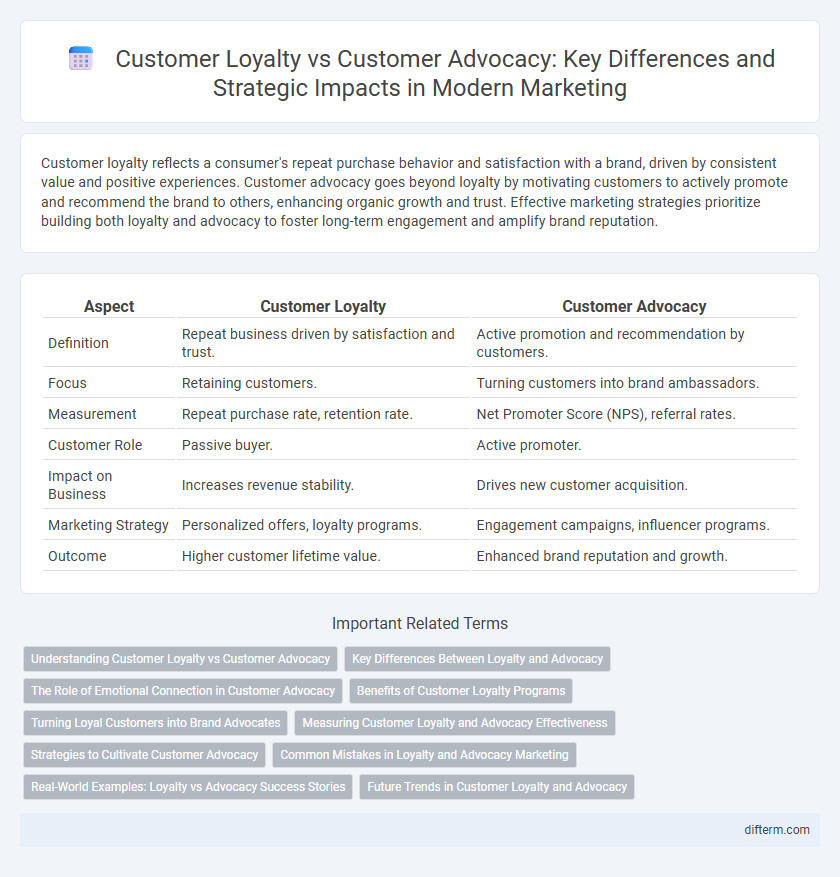Customer loyalty reflects a consumer's repeat purchase behavior and satisfaction with a brand, driven by consistent value and positive experiences. Customer advocacy goes beyond loyalty by motivating customers to actively promote and recommend the brand to others, enhancing organic growth and trust. Effective marketing strategies prioritize building both loyalty and advocacy to foster long-term engagement and amplify brand reputation.
Table of Comparison
| Aspect | Customer Loyalty | Customer Advocacy |
|---|---|---|
| Definition | Repeat business driven by satisfaction and trust. | Active promotion and recommendation by customers. |
| Focus | Retaining customers. | Turning customers into brand ambassadors. |
| Measurement | Repeat purchase rate, retention rate. | Net Promoter Score (NPS), referral rates. |
| Customer Role | Passive buyer. | Active promoter. |
| Impact on Business | Increases revenue stability. | Drives new customer acquisition. |
| Marketing Strategy | Personalized offers, loyalty programs. | Engagement campaigns, influencer programs. |
| Outcome | Higher customer lifetime value. | Enhanced brand reputation and growth. |
Understanding Customer Loyalty vs Customer Advocacy
Customer loyalty reflects a customer's repeated purchases and preference for a brand, driven primarily by satisfaction and reward programs. Customer advocacy goes beyond loyalty, involving customers who actively promote and endorse the brand through word-of-mouth and social media engagement. Organizations aiming for sustainable growth prioritize transforming loyal customers into advocates to amplify brand credibility and attract new clientele.
Key Differences Between Loyalty and Advocacy
Customer loyalty centers on repeat purchases and sustained preference for a brand, driven by satisfaction and rewards, whereas customer advocacy involves enthusiastic recommendations and active promotion of the brand to others. Loyalty is often nurtured through loyalty programs and personalized experiences, while advocacy grows from emotional connections and exceptional service that inspire customers to endorse the brand voluntarily. Measuring loyalty relies on metrics like repeat purchase rate and customer retention, whereas advocacy is gauged through referral rates, Net Promoter Score (NPS), and social sharing behaviors.
The Role of Emotional Connection in Customer Advocacy
Emotional connection in customer advocacy drives stronger brand attachment, increasing repeat purchases and positive word-of-mouth referrals. Unlike customer loyalty, which primarily reflects repeated transactions, advocacy involves genuine enthusiasm and trust that motivates customers to actively promote a brand. Brands that cultivate emotional bonds through personalized experiences and authentic engagement see higher advocacy rates and sustainable growth.
Benefits of Customer Loyalty Programs
Customer loyalty programs enhance repeat purchases by rewarding consistent customer behavior, which increases lifetime value and reduces churn rates. These programs provide valuable data insights into customer preferences and buying patterns, enabling personalized marketing strategies that boost engagement. Loyalty initiatives also foster emotional connections and trust, turning customers into brand advocates who drive organic growth through word-of-mouth referrals.
Turning Loyal Customers into Brand Advocates
Customer loyalty reflects consistent repeat purchases and positive sentiment toward a brand, while customer advocacy goes further by actively promoting and recommending the brand to others. Turning loyal customers into brand advocates involves delivering exceptional experiences, personalized engagement, and incentivizing word-of-mouth referrals through loyalty programs and exclusive rewards. Brands that successfully convert loyalty into advocacy can amplify organic growth, enhance reputation, and build a sustainable competitive advantage in the marketplace.
Measuring Customer Loyalty and Advocacy Effectiveness
Measuring customer loyalty involves tracking repeat purchase rates, customer retention metrics, and Net Promoter Score (NPS) to assess consistent brand preference. Customer advocacy effectiveness is evaluated through referral rates, social media mentions, and customer testimonials highlighting brand endorsement. Combining quantitative data like purchase frequency with qualitative indicators such as sentiment analysis provides a comprehensive view of loyalty and advocacy impact.
Strategies to Cultivate Customer Advocacy
Effective strategies to cultivate customer advocacy involve delivering exceptional customer experiences that exceed expectations and foster emotional connections. Leveraging personalized engagement, rewards programs, and proactive support encourages customers to share positive word-of-mouth and become brand ambassadors. Investing in transparent communication and community-building initiatives further strengthens trust and long-term customer advocacy.
Common Mistakes in Loyalty and Advocacy Marketing
Confusing customer loyalty with customer advocacy often leads marketers to overlook the distinct motivations that drive each behavior, resulting in generic engagement strategies that fail to inspire genuine brand promotion. Relying solely on rewards programs to boost loyalty neglects the emotional connection and trust that turn loyal customers into advocates. Failing to measure advocacy specifically, such as tracking Net Promoter Score (NPS) alongside loyalty metrics, impairs the ability to identify true brand champions who actively refer and endorse the company.
Real-World Examples: Loyalty vs Advocacy Success Stories
Starbucks exemplifies customer loyalty through its robust rewards program, driving repeat visits and sustained revenue growth by incentivizing regular purchases. In contrast, Apple showcases customer advocacy by fostering passionate brand evangelists who actively recommend products, resulting in organic growth and elevated brand prestige. Both approaches highlight distinct strategies: loyalty programs boost short-term retention, while advocacy cultivates long-term brand influence via genuine customer endorsements.
Future Trends in Customer Loyalty and Advocacy
Future trends in customer loyalty emphasize personalized experiences driven by AI and data analytics, allowing brands to anticipate and meet evolving consumer needs. Customer advocacy is increasingly powered by social proof and influencer partnerships, leveraging authentic user-generated content to build trust and brand credibility. Integrating loyalty programs with seamless omnichannel engagement will transform how brands foster long-term relationships and amplify advocacy efforts.
Customer loyalty vs Customer advocacy Infographic

 difterm.com
difterm.com